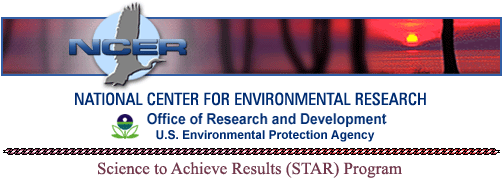
http://engineering.ucdavis.edu/


Objective(s) of the Research Project:
San Pablo Bay, a subembayment of the San Francisco Bay, is subject to the influence of several major environmental stressors. These include sediment loads; heavy metal and pesticide residues from California's Central Valley, the Sierra Nevada and the coastal range; industrial waste from the San Francisco Bay Area (including several oil refineries); and chemical waste from the Mare Island Naval Shipyard (now closed).
An extensive set of potential indicators, including chemical, biochemical, and ecological variables, will be tested in designing a monitoring network that is temporally and spatially adequate to provide advance warning of the ecological impacts of natural and anthropogenic stressors. Two chemical measures of contaminant bioavailability, supercritical fluid extractability, and aqueous desorption potential, will be used in investigating relationships between sediment-borne contaminant fluxes and toxicity. Biochemical indicators of toxicity will be analyzed in two sediment dwelling members of the San Pablo Bay food chain: the bivalve Macoma balthica and the crustacean Ampelisca abdita. Monitoring sensitive biochemical and cellular indicators of deleterious effects should foretell subtler and possibly longer term consequences of exposure to chemicals in the environment. Sublethal effects such as protein damage, lysosomal destabilization, metabolic alterations, and tissue damage will be compared to contaminant body burden and higher level effects such as growth and mortality. Ecological stress indicators to be considered include number and diversity of species within benthic assemblages, contaminant bioaccumulation in fish tissue, and reproductive success for two bird species, double-crested cormorants (Phafacrocorax auritus) and song sparrows (Melospiza mefodia). Hatchability, clutch size and, for song sparrows, nestling survival will be evaluated as indicators of ecological condition.
Progress Summary/Accomplishments:
The first year's activities have seen all components of the project move ahead. Six months of continuous current, salinity, and suspended sediment data have been collected, and presently are being analyzed. Chemical sampling and analysis protocols have been developed and tested. Initially, the extensive data set will be applied to understanding the nature of a recent toxicity event in the study area. Laboratory testing of biochemical (stress proteins), cellular (lysosomal membrane stability), and histological (tissue damage) stress indicators have been commenced for the bivalve M. balthica and the crustacean A. abdita. The heavy metal cadmium and the pyrethroid insecticide esfenvalerate ("Asana") were chosen as model pollutants for laboratory studies. In addition, we are investigating the effects of natural stressors (e.g., salinity and temperature variations) on the selected stress indicators. To date, esfenvalerate has shown some interesting results. Studies on our two bird species: song sparrows and double-crested cormorants, have been underway for one breeding season. Double-crested cormorants are being used as an indicator for the open waters of San Pablo Bay, and song sparrows as an indicator for the ecological condition of marshes in the San Pablo Bay ecosystem. Hatchability results suggest good reproductive success. Chemical analyses for viable and non-viable eggs are ongoing, and fish tissue analyses are still being conducted.
Publications/Presentations:
Warner JC, Schladow SG, Schoellhamer D, Burau J. Effects of tidal current phase at the junction of two straits. To be presented at the 10th International Biennial Conference on Physics of Estuaries and Coastal Seas, 2000.
Schladow SG, Youq T, Werner I, Warner JC, Veir J, Baum J, Pincetich C, Schoellhamer D, Thompson B, Davis J, Lowe S, Nur N, Spautz H, Roberts C, Fainy R, Ichikawa G, Crane D. CISNet San Pablo Bay network of environmental stress indicators. Presented at the Interagency Ecological Program (IEP) Annual Conference, Asilomar, CA, 2000.
Warner JC, Schladow SG, Schoellhamer D, Burau J. Napa-Sonoma Marsh Hydrodynamic Study for wetlands restoration. Presented at the 4th Biennial State of the Estuary Conference, San Francisco, CA, 1999.
Future Activities:
Based on our collective experiences of the past year, we are reasonably confident that the planned activities, as described in the original proposal, can be conducted successfully. During this period, we believe we can overcome the analytical backlog, and implement a system whereby chemical analyses are conducted in a more timely manner. A second 6-month deployment (two 3-month deployments back-to-back) of continuously recording current, salinity, and OBS instruments is planned to commence in September. The avian and fish sampling programs are scheduled to proceed as before. The first stage of the demonstration modeling also is scheduled to start this year.
One new focus that has arisen is the recent reporting of a "toxicity event" in the study area. This presently is being evaluated using project data and, depending on the outcome, this may cause us to reevaluate our sampling strategies.
Supplemental Keywords: water, watersheds, sediments, estuary, adsorption, chemical transport, ecological effects, bioavailability, chemicals, toxics, particulates, PAH, PCB, metals, ecosystem, indicators, restoration, terrestrial, aquatic, monitoring, west, Region 9.
Relevant Web Sites:
http://www.sfei.org 
http://engineering.ucdavis.edu/

Original Project Abstract
2000 Progress Report
Communicate | Search | Back to NCER | Back to ORD | Back to EPA
Last Updated: June 6, 2002